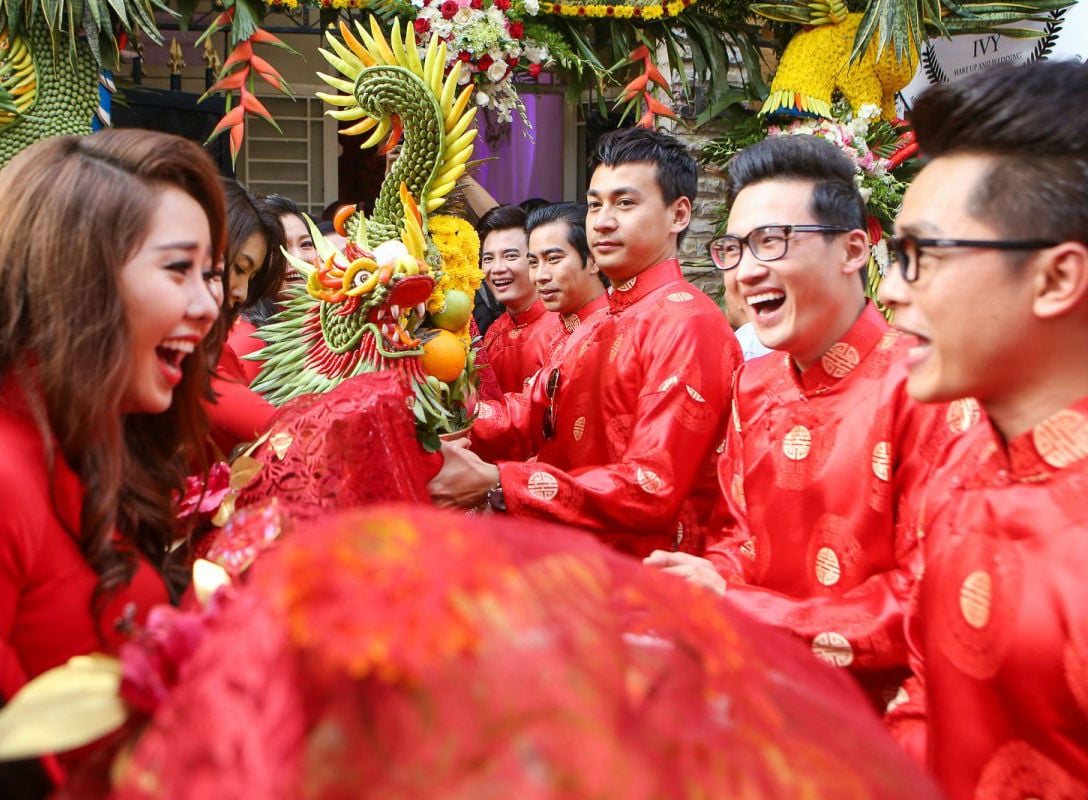
One of the most captivating aspects of traveling to Vietnam is the exploration of its unique and ancient Vietnamese culture. Nestled within the vibrant cultural mosaic of Vietnam is a time-honored tradition that transcends generations and paints a vivid portrait of love and commitment: the country's captivating wedding ceremonies. Read on for more insights about Vietnam wedding traditions, from the ceremonies to the Vietnam wedding dress and more.
1. What are the symbols of Vietnam wedding traditions?
Vietnam wedding traditions are rich with symbolic elements that add depth and meaning to the celebration of love. Here are some of the most common symbols you can see at Vietnamese weddings.
- "Song Hy" word (Double happiness): Traditional Vietnam weddings beautifully incorporate the symbol of "Song Hy," an emblem of doubled joy formed by combining two characters representing happiness. Originating from Chinese culture, "Song Hy" signifies the collective joy of both the groom's and bride's families as they unite. This symbol, written in Han script, is omnipresent in Vietnamese weddings, adorning wedding invitations, newlywed homes, and ceremonial cards.
- Betel leaves and areca nut (Trau cau): At the heart of traditional Vietnamese weddings lies the profound symbolism of “trau cau,” where the sturdy trunk represents the groom and the betel leaves embody the bride. The intertwined vines symbolize a resilient and enduring love, making the betel leaves an indispensable part of the Vietnam wedding ceremony. This symbolic gesture represents not only the couple's harmonious union but also conveys wishes for a resilient and lasting bond.
- Money offering (Tien nap): Traditional Vietnamese weddings include the custom of presenting money as a gesture of respect from the groom's family to the bride's family. This financial offering serves as practical support, covering wedding preparation expenses or providing economic assistance to the newlyweds, showcasing the communal nature of wedding traditions in Vietnam.
- “Husband and wife” cake (Banh phu the): The symbolic Vietnamese wedding cake stands as a visual representation of marital unity. With its dual green layers symbolizing the enduring bond between husband and wife, this confection carries a sweet and fragrant taste, mirroring the profound sweetness of the couple's heartfelt connection.
- Wedding rings: Vietnam wedding traditions incorporate the exchange of engagement and wedding rings. The engagement ring symbolizes a unique bond and trust, as the bride accepts it during a proposal. The wedding ring, exchanged during the marriage ceremony, becomes a tangible symbol of enduring commitment, serving as a constant reminder of the couple's responsibilities to one another.
- Numbers: Intriguingly, numbers play a crucial role in traditional Vietnamese weddings, with even numbers such as 8, 10, or 12 being favored. The use of paired items, representing completeness and unity, adds a layer of symbolism to the ceremonies and emphasizes the couple's journey together as one.
- Pigeon: Pigeons, known for their lifelong commitment to a single partner, serve as a symbolic representation of harmony and devotion in traditional Vietnamese weddings. Frequently gifted as paintings or statues, these birds convey blessings for the newlyweds, symbolizing a love that endures the test of time.
- Phoenix: The presentation of a phoenix, often in the form of artwork or figurines, encapsulates wishes for the couple's enduring happiness and good fortune throughout their shared journey.

>>> Explore more about the origin and meaning of the Vietnamese symbol for love!
2. The 6 important ceremonies in Vietnam wedding traditions
Wedding traditions in Vietnam are deeply rooted in cultural significance, symbolizing the sanctity of marital bonds and the familial ties of Vietnamese people. Comprising six essential ceremonies, these wedding traditions in Vietnam guide the journey from the initial proposal to post-wedding expressions of gratitude.
2.1. Proposal ceremony (le dam ngo)
Considered the first ritual in Vietnamese marital customs, the proposal ceremony formalizes the marital relationship. It is a simple event where the groom's family visits the bride's home to discuss and officially express their intention for marriage. Despite its cultural simplicity, this ceremony holds great significance, marking the commencement of a complete marital journey. The proposal ceremony reflects meticulousness, respect, and a sense of responsibility for the happiness of the couple and their families.

2.2. Engagement ceremony (le an hoi)
The engagement ceremony is a crucial step in the traditional Vietnam wedding, especially for the bride's family. After discussions and finding an auspicious date, the groom's family prepares the requested offerings, and the groom officially seeks approval to become the bride's husband. This phase is akin to an engagement and serves as the formal announcement and promise of marriage. The engagement rituals include various customs such as incense lighting, ancestral worship, introducing relatives, and a Vietnamese wedding tea ceremony with close guests.

2.3. Bride-asking ceremony (le xin dau)
The bride-asking ceremony is a small ritual conducted before the formal bride procession. It serves as a final request for permission before officially bringing the bride into their family. Although seemingly simple, meticulous preparation is essential to demonstrating the groom's family's respect for the bride's family. In this ritual, representatives from the groom's family bring betel leaves and Vietnam wedding gifts, symbolizing the request to marry the bride. The bride-asking ceremony exemplifies the meticulousness preserved in Vietnam wedding traditions over generations.

2.4. Bride procession ceremony (le ruoc dau)
Following the bride-asking rituals at the bride's home, the groom, adorned with a bridal bouquet and ceremonial offerings, formally welcomes the bride to his home. Traditional Vietnam wedding customs involve exchanging symbolic traditional Vietnamese wedding gifts and offerings representing wishes for the couple's happiness. This procession, an important part of wedding traditions in Vietnam, symbolizes the beginning of a happy, prosperous life for the newlyweds.

2.5. Wedding ceremony (le cuoi)
The wedding ceremony is the pinnacle of Vietnam wedding traditions. After completing all rituals in both families, the couple hosts a celebratory feast to announce the joyous news to friends and family. Attended guests are treated to a lavish meal, fine wine, and betel nuts, while the bride and groom personally visit each table to express gratitude and officially introduce their marital relationship. Vietnamese wedding songs are played throughout the ceremony to increase the joy and excitement of the event.

2.6. Post-wedding ceremony (le lai mat)
The post-wedding ceremony marks the final step after the wedding festivities. The couple returns to the bride's family, bringing offerings such as chickens, rice, sweets, and wine as a gesture of gratitude. This ceremony emphasizes the appreciation of the newlyweds towards their respective parents, acknowledging their role in nurturing them. Traditional Vietnamese wedding attire tends to be simple and comfortable, focusing on expressing respect, gratitude, and a joyful attitude towards the bride's parents. Though less elaborate, the post-wedding ceremony remains a vital tradition in Vietnam wedding traditions.

>>> Learn more about traditional Vietnamese culture!
3. Differences in Vietnam wedding traditions in the three regions
3.1. Vietnam wedding traditions in the North
In Northern Vietnam, wedding ceremonies typically follow three main steps: "dam ngo" (proposal ceremony), "an hoi" (engagement ceremony), and "don dau" (bride asking ceremony). Some families may also include the post-wedding ceremony. The Northern Vietnam wedding traditions also include a custom where the groom's family requests specific traditional Vietnamese wedding gifts, including betel leaves and young sticky rice cake.

Wedding regulations in the North are the strictest among the three regions. Choosing an auspicious date is crucial, and engagement ceremonies must be held at least one week to ten days before the wedding. In the past, engagement and wedding ceremonies were held on separate days so that both families had ample time for preparation and guest invitations. The bride possession ceremony in the North involves numerous rituals, with wealthy and respected individuals leading the bridal procession.
3.2. Vietnam wedding traditions in the Central
In Central Vietnam, particularly in the former imperial city of Hue, weddings are characterized by simplicity, frugality, and a focus on ceremonial significance rather than material aspects. Before the engagement and wedding ceremonies, families often consult Buddhist monks to choose auspicious dates and times. The proposal ceremony may be conducted by the couple themselves if the families are already acquainted.

Engagement ceremonies in Central Vietnam are considered significant gatherings, including rituals such as asking for an auspicious hour, exchanging vows, paying respects to the ancestral altar at the bride's house, receiving the bride, and holding a family union ceremony at the groom's house. Unlike the North, there is no tradition of giving gifts in Central Vietnam. A special tradition of Central Vietnam weddings is a ritual known as "giao boi hap can," where the newlyweds chew betel leaves, symbolizing harmony for the 12 months and 12 years ahead.
3.3. Vietnam wedding traditions in the South
People in South Vietnam tend to have a more relaxed mindset. This is reflected in their wedding customs, which are less formal and allow more flexibility. While still observing the three essential steps of the proposal ceremony, engagement ceremony, and bride procession ceremony, Southerners might combine the engagement and bride possession ceremonies on the same day for convenience if the families live far apart.

However, a mandatory ritual in southern weddings is the "len den" ceremony. The groom, carrying two large candles, visits the bride's house during the bride procession ceremony. Lighting the candles during the ancestral altar ceremony symbolizes the official declaration of the couple's lifelong commitment.
Despite regional differences in customs and beliefs, all families share the common hope that these Vietnam wedding traditions will bring lasting happiness to the newlyweds, guiding them towards a smooth and harmonious life together.
4. A glance at dressing in Vietnam wedding traditions
4.1. Vietnam wedding dress for groom and bride
The traditional Vietnamese wedding dress for the bride and groom is the “áo dài”. During engagement and wedding ceremonies, the bride and groom typically wear traditional ao dai to introduce themselves to both sides of the family and ancestors. The bride's ao dai usually adheres to traditional designs, while the groom's ao dai embraces a more modern style.
Brides and grooms can choose a matching set of ao dai for wedding and engagement ceremonies. These sets often share similar styles, colors, materials, and patterns, creating a harmonious and coordinated look for the couple.

Brides and grooms often prioritize choosing ao dai in colors like red, white, yellow, pink, or green. Traditional wedding ao dai, while maintaining their cultural charm, often incorporate modern elements, adding a touch of personality and youthfulness to the bride and groom.
For the later part of the Vietnam wedding ceremony, when the couple welcomes guests and participates in the main ceremony, the bride switches to a wedding gown, while the groom opts for a vest. The bride's wedding gown may feature a wide flare, fishtail, or fitted style. Typically, brides choose pristine white wedding gowns, and the groom dresses in a wedding vest.
4.2. Vietnam wedding dress for families of groom and bride
Following wedding traditions in Vietnam, both families traditionally wear the Ao dai during the wedding ceremony, occasionally opting for formal modern clothing.

Mothers of the bride and groom typically wear the traditional Ao dai, while the father of the groom may wear a vest with accessories like a tie. The design for mothers emphasizes modesty, elegance, and sophistication, with subtle patterns and colors that accentuate the grace of middle-aged women.
4.3. Vietnam wedding dress for groomsmaids and bridesmaids
The attire of groomsmaids and bridesmaids for the wedding ceremony often consists of traditional ao dai, modernized ao dai, or bridesmaids in dresses and groomsmen in white shirts, trousers, and accessories like bowties or neckties. However, couples tend to choose traditional ao dai for their groomsmaids and bridesmaids.

Bridesmaids' ao dai usually features simple patterns, and solid-colored traditional ao dai is also popular. The color tone is gentle, complementing the bride's ao dai. This coordinated attire contributes to a charming and harmonious appearance for the wedding party.
>>> Check out the most prominent wedding destinations in Vietnam!
As you immerse yourself in the rich Vietnam wedding traditions, consider extending your journey to explore the country's diverse landscapes, history, and culture. From the bustling cities of Hanoi and Ho Chi Minh City to the serene beauty of Phu Quoc, Nha Trang, Hoi An, and the iconic Ha Long, Vietnam travel offers a myriad of captivating experiences.
Enhance your stay with the luxurious accommodations provided by Vinpearl's hotels and resorts, where opulence meets comfort. Vinpearl is renowned for outstanding services and impressive facilities, providing an enjoyable stay for travelers. Whether you're looking for a relaxing retreat or a luxurious experience, Vinpearl has everything to satisfy your desires, from exquisite rooms with stunning views to swimming pools, gyms, spas, bars, restaurants, and so on.

Moreover, discover the enchanting world of entertainment at VinWonders. VinWonders is a system of entertainment complexes where you can experience everything from exhilarating rides to family-friendly attractions and immersive cultural experiences.

>>> Book rooms in Vinpearl Phu Quoc, Vinpearl Nha Trang, Vinpearl Resort & Golf Nam Hoi An, Vinpearl Resort & Spa Ha Long for a luxurious stay in Vietnam!
Vietnam wedding traditions are a mesmerizing blend of ancient customs and contemporary celebrations. From symbolic gestures to elaborate ceremonies, these traditions showcase the deep cultural roots that make traditional Vietnamese weddings truly enchanting. So, come and experience this cultural phenomenon in Vietnam!
























